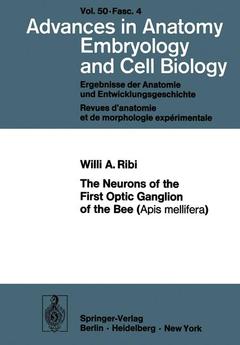Description
The Neurons of the First Optic Ganglion of the Bee (Apis mellifera), 1975
Advances in Anatomy, Embryology and Cell Biology Series, Vol. 50/4
Author: Ribi W.A.
Language: English
Subject for The Neurons of the First Optic Ganglion of the Bee ...:
Publication date: 03-1975
43 p. · 17x24.4 cm · Paperback
43 p. · 17x24.4 cm · Paperback
Description
/li>Contents
/li>
The visual system of insects has attracted histologists for a long time. We have detailed histological studies of the visual systems of Diptera, Hymenoptera and Odonata dating from the last century: Leydig's (1864) study on optical ganglia of insects, Ciaccio's (1876) on the fine structure of the first ganglion in the mosquitos and Hickson's (1885) giving for the first time an exact description of the three optical ganglia of Musca. From 1896 several papers appeared using neuro histological methods, mainly Golgi techniques and methylene blue staining. In 1896 Kenyon published his work on the bee-brain and in 1897 described the relationships of neurons in the optic ganglia with a modified Golgi method. Another work, by Jonescu (1909), should be mentioned: "Vergleichende Unter suchungen am Gehirn der Honigbiene". In the same year Cajal's findings on the optic ganglia of the fly were published, then in 1915 Cajal and Sanchez wrote a definitive monograph on the neural elements and their connections in the same animal that remained the main reference in this field for decades. In both works Golgi techniques were used. Since then there have been only a few new publications on the subject: (Gribakin, 1967, Perrelet and Baumann, 1969 a, b, Perrelet, 1970, Varela and Porter, 1969, Skrzipek and Skrzipek, 1971, 1973, Grundler, 1972: Snyder, Menzel and Laughlin, 1973). They deal mainly with the receptors of the retina.
I. Introduction.- II. Material and Methods.- 1. Reduced silver impregnation.- 2. Methylene blue staining.- 3. Golgi’s selective silver impregnation.- 4. Technical equipment.- III. Results.- 1. Morphology of the lamina.- 2. Localization of cell bodies in the peripheral visual system.- 3. Retina- lamina and lamina- medulla projections.- 4. Lamina fibres.- 5. Outer chiasma.- 6. Medulla.- IV. Discussion.- Summary.- 1. General anatomical features.- 2. Retinula- (svf and lvf) and lamina-fibers (L-, am-, T-, C-,).- 3. Discussion of the connection pattern.- Acknowledgements.- References.
© 2024 LAVOISIER S.A.S.




